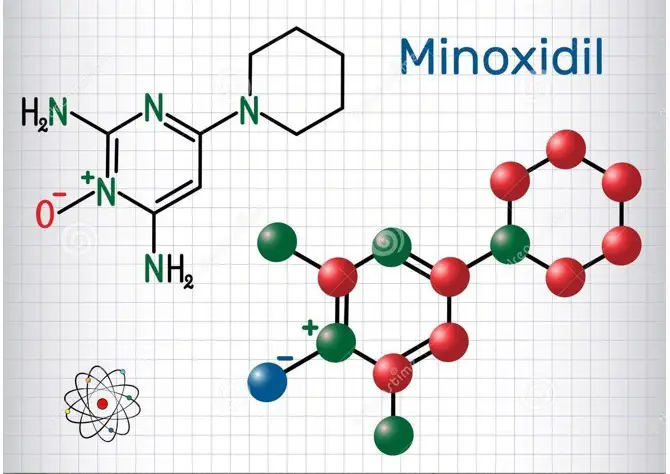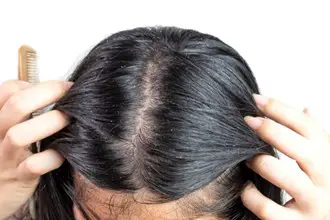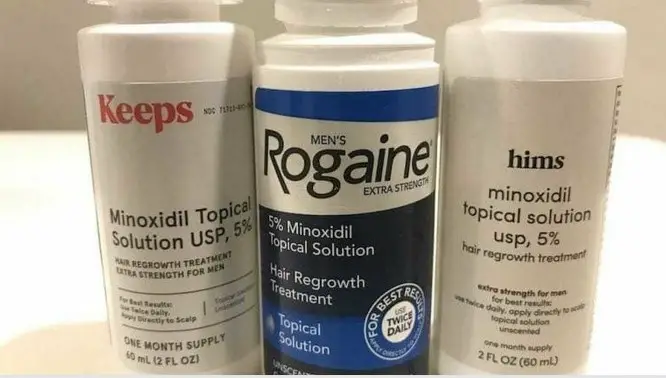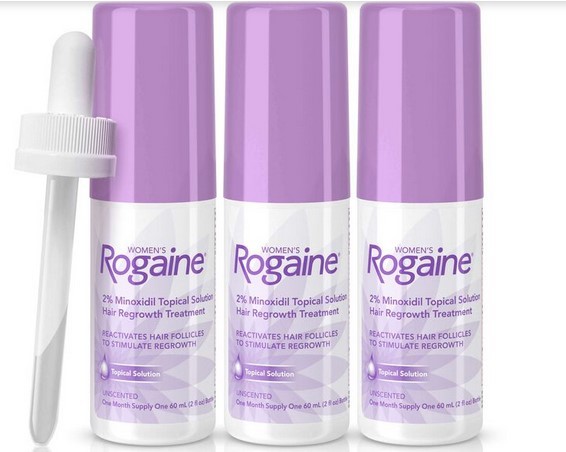We often hear people asking if minoxidil stops working overtime and if minoxidil once a week works better than minoxidil twice a day. It’s well known that the top cause of hair loss in men and women, especially as they age, is due to DHT, or dihydrotestosterone. DHT works by binding itself to receptors on the outer layer of your hair follicles, causing them to shrink over time until eventually disappearing completely, leading to permanent hair loss.
So we have done some deep research about how minoxidil stopped working in the treatment of male and female pattern baldness. Since numerous hair loss treatment use this formula, e.g. Nioxin and Regaine contains Minoxidil, it has come to our attention to find out why does minoxidil stop working overtime and how does Minoxidil work?
Regaine stop working overtime
The Myth of Stopping Minoxidil (Regaine) Over Time: If you’re dealing with hair loss, you probably have heard about minoxidil. This popular hair loss treatment has been around for decades, and it is one of most effective treatments out there. But what happens when minoxidil stops working over time? Does it stop working altogether or does it just become less effective in fighting your baldness as time goes on? Let’s take a look at what actually happens when you stop using minoxidil once a week, as well as what can be done to keep your results going strong.
What is minoxidil?
Minoxidil belongs to the class of treatment called “Potassium Channel Openers” that was used in high blood pressure treatment. Originally introduced in the ’70s as a treatment for hypertension, Minoxidil became the only approved drug from the “Potassium Channel Openers” category for use in humans, despite the number of drugs researched from this class.
Medication of minoxidil results after 6 months in some undesirable hair growth for its side effect. This observation led to the development of a topical formulation of Minoxidil in treating pattern baldness in men and later on in women [1].
Today, two types of Minoxidil appear in the market, each treating different conditions. One type is Oral Minoxidil that treats high blood pressure, while the topical solution form of Minoxidil is used as a treatment for hair loss, Minoxidil beard, and baldness. The US market has first seen 2% topical Minoxidil in 1986 as a hair-grower, and the 5% became available in 1993.
Related: Can used Rogaine once a day
Minoxidil side effects after stopping using
When you stop using minoxidil, it doesn’t take long for side effects to show up. Within a week of your last application, you may start noticing itching, flaking, and some irritation. This is what people refer to as minoxidil itch and it’s actually caused by dying hair follicles – something that should be considered permanent side effects of minoxidil use. But even if you don’t experience these side effects after stopping minoxidil use outright, other ones might appear as well including:
Response of the hair follicle to minoxidil
Drugs are known to stimulate hair growth in many ways. Some drugs increase the linear growth rate of hair, others may increase the diameter of the hair fiber, some may alter the hair cycle – by shortening the telogen or prolonging the anagen, and certain drugs containing Minoxidil may cause the hair follicles to respond differently with the combination of these effects.
- The function of Minoxidil in stimulating hair growth has already been established, but the knowledge on the working mechanism of Minoxidil is bounded.
- Topical Minoxidil shortens telogen, thus causing premature entry of resting hair follicles into anagen in the result of the extensive animal studies conducted on stump-tailed macaque to determine the effects of Minoxidil in hair growth. Histological inspection on these primates showed that Minoxidil treatment causes a proportional increase in anagen follicles, a decrease in the telogen follicles, and an increase in the size of the hair follicle.
However, the only noted minoxidil side effects after stopping treatment in humans is its role in the human hair cycle, although the possibility of Minoxidil increasing the hair diameter is still studied.
Minoxidil dark circles
At some point, all of us will start to notice fine lines and wrinkles on our face. This usually happens when we hit our mid-30s or 40s. So what do you do when minoxidil treatments no longer work? How long do minoxidil stop working for you? Do you have dark circles under your eyes after using it for a long time? Here are 3 things you can try if your minoxidil is not working anymore:
1. Stop applying it once a week; instead apply twice a day – morning and night.
2. Apply two or three thin layers of solution in each application, instead of one thick layer as before
3. If none of these ideas help, then that could mean that it’s time to change your treatment brand or medication strength. Be sure to consult with your doctor about these changes first though, so he/she can make recommendations for best results. For example, if you change from 5% Minoxidil Finasteride Foam to 10% Minoxidil Finasteride Foam, then chances are high that you may see improvement right away.
Just remember that it takes at least 4 months before minoxidil really starts working (i.e., 5% solution takes 4 months), so don’t expect results overnight even with higher concentrations! To save more money without compromising on efficacy is another way – purchase larger quantities of products so you don’t need to purchase again soon!
Minoxidil side effects in women hair loss Treatment
Topical application on normal intact skin with Minoxidil is not well absorbed; only 0.3 to 43.5 percent reaches the systematic circulation, which is eliminated out of the system within 4 days from application. However, the effects on absorption of concomitant occlusion and the systematic metabolic biotransformation of topically applied Minoxidil are mostly unknown.
Contact dermatitis if notice (scalp irritation, dryness, itching, scaling, and redness) is the most common side effect of Minoxidil. See minoxidil shedding pictures.
- Hypertrichosis – excessive growth of hair in areas normally not hairy, a side effect of Minoxidil uncommon to men, was known to affect 3 to 5% of women using Minoxidil. It’s unclear why hypertrichosis occurs, but it is possible through either a systemic effect or via transfer of the drug. Areas commonly affected are the forehead, malar areas, and sides of the face. This condition, however, may diminish with continued treatment over the course of a year, or it resolves completely within a few months once treatment is stopped.
- Predisposing factors of hypertrichosis – are existing facial hairs, higher dosage, and old age over 50 years. Care should be taken to avoid the manual spread of the agent by pillows to sites other than the scalp, but local absorption is still believed to be the cause of the problem.
- Change in blood pressure – or any other systematic effects of Minoxidil solution was not evident from studies done, but patients with cardiovascular disease are advised to use the agent with caution. Pregnant and lactating mothers are also advised to avoid using the product. Although there is no evidence of teratogenicity in rats and rabbits, the Minoxidil has been found to be secreted through breast milk.
You can get more info here: https://www.mayoclinic.org/drugs-supplements/minoxidil-topical-route/precautions/drg-20068750?p=1
Understanding how Minoxidil works can help many through the development of more effective treatments for hair loss disorders and why minoxidil stops working after a while, as much as it can help science in unravelling the biology of hair growth.
How Minoxidil Works?
In animal studies, Minoxidil does not stimulate the secretion of testosterone or adrenal androgen secretion; thus, it does not have any anti-androgen effects. There was no noted change in the testosterone levels after Minoxidil was administered to humans.
It was so thought that Minoxidil acts on the system by increasing the amount of blood present in the hair follicle, since Minoxidil was originally used to treat high blood pressures. However, vasodilation or the dilation of the blood vessels is not noticed on other Potassium Channel Openers including Minoxidil, thus the association with vasodilation in hair growth is rejected.
A component of Minoxidil, the Minoxidil sulfate, was observed to be the active metabolite responsible for stimulating hair growth. When Minoxidil is taken orally, it relaxes the vascular smooth muscle by the action of the sulphated metabolite– the Minoxidil sulphate – in its component as an opener of the sarcolemnal KATP channels, thus lowering the blood pressure. Subsequent studies on the whisker follicles and on the stump-tail macaque showed that the stimulatory effect of Minoxidil on hair growth is also due to the opening of potassium channels by Minoxidil sulphate.
This idea remains unproven, as to date KATP channels expressing in the hair follicles are difficult to demonstrate.
Prolongation of keratinocyte growth and an increase in the proportion of hairs in anagen in monkeys and humans exhibiting pattern baldness are but some well-recognized effects of Minoxidil. There were also other experiments conducted, resulting in support of Minoxidil’s role in the prolongation of the survival time of keratinocytes in vitro.
Related; Minoxidil Tretinoin treatment for pattern baldness
The Cellular Response to How Minoxidil Works
The unknown mechanism that allows Minoxidil to modulate hair growth affects cellular function. The hair follicle has a complex structure that is made up of epithelial, dermal, pigment, and immune cells, a perifollicular vasculature, and a neural network.
The interactions between the cells are involved in the regulation of the hair cycle and epithelial growth and differentiation. Many studies had been done to isolate several of these cells to be able to study the Minoxidil action but until now, researchers have been unsuccessful in locating the Minoxidil metabolite that binds to a specific cell population within the hair follicle.
In monocultures of the various skin and fair follicle types, there were quite a number of in vitro effects of Minoxidil which include stimulation of cell proliferation, inhibition of collagen synthesis, stimulation of vascular endothelial growth factor, and prostaglandin synthesis. Some or all of these effects may eventually lead to the solution of the hair-growth problem.
All the results show that Minoxidil increases vascular endothelial growth factor (VEGF) in cultured dermal papilla cell extracts. VEGF is associated with blood vessel formation and is usually strongly expressed in anagen dermal papilla in the presence of a highly vascular network, and a decreased in telogen when these blood vessels are absent. Thus, some authors theorized that Minoxidil could play a key role in the regulation of dermal papilla vascularization.
My thoughts on minoxidil stops working
Some of you might be wondering if minoxidil stops working after 6-8 months. For some people it does, for others it doesn’t. The big reason why some people experience hair growth with minoxidil, and others don’t is because of their genes (androgenic alopecia). We know that androgenic alopecia is inherited from both sides of your family; therefore we are all predisposed to losing our hair (since most of us get our genes from both parents). Androgens are male hormones such as testosterone that work by causing miniaturization in hair follicles on your scalp.
You will also like: Nutri Ox vs Nioxin | Which is Best For Hair Loss?
Efficacy Minoxidil for female hair loss
Two percent (2%) topical Minoxidil, the only FDA-approved agent for female pattern hair loss treatment, showed efficacy over placebo in many trials.
- Investigator global assessment determined – through a well-designed 32-week study – that the application of 2% Minoxidil twice-daily stimulated mild to moderate re-growth in 63% of 157 women treated with Minoxidil compared to 39% of 151 women treated with vehicle.
- Non-vellus hair counts on the top of the scalp of 256 women aged 15 to 45 years suffering Ludwig I or II alopecia treated with 2% topical Minoxidil showed a mean increase of 14 percent over baseline compared with 7.3 percent for those on placebo. Results were taken from a 32-week trial period.
- To assess the efficacy and safety of 2% topical Minoxidil solution for the treatment of pattern baldness in women, 10 European centers conducted a 32-week, double-blind, placebo-controlled trial; results led to the conclusion that topical Minoxidil solution was significantly more effective than placebo in the treatment of pattern baldness in women. The mean increase in the non-vellus hair count in the 2% percent Minoxidil group was 33 hairs, significantly greater than that of 19 hairs in the placebo group. Investigators saw 44 percent new growth of those treated with topical Minoxidil and only 29 percent of those on placebo.
The outcome on women with hyperandrogenism may not be as positive, however. FDA-controlled studies on women showed no evidence of increased effectiveness of the 5% solution.
No significant difference in scalp coverage could be appreciated by investigator global assessment in a 48-week, well-designed comparative efficacy study of the 5% versus the 2% topical Minoxidil in the treatment of mild to moderate female pattern hair loss.
Patient satisfaction with the use of the higher concentration, however, was appreciably greater. Using higher concentration in women showed modest benefit at best, and its use should only be considered in those cases that show minimal response to the 2 percent formulation; as shown by subsequent studies.
Studies using hair counts as a primary endpoint in the evaluation of female pattern hair loss have shown a mean increase in hair growth of 15-33% in the Minoxidil-treated goops compared to the 9-14% increase in the vehicle groups. On the other hand, one small study using hair weights as the endpoint found an increase of 42.5% in hair weights in the Minoxidil group compared to the 1.9% in the control group.
Minoxidil was superior over the vehicle in the investigator and subject assessments. However, 40 percent of the subjects appeared not to respond to Minoxidil. It’s also important to note that none of these trials were extended over 32 weeks, and the long-term results of Minoxidil treatment are uncertain.
The beneficial effects on hair growth on men are lost rapidly on cessation of treatment and it is most likely that the same effect will hold true in the case of women.
Can i use minoxidil once a week
Minoxidil can safely be used once a week and will still produce results. It is important to remember that minoxidil should be used continuously to maintain its effectiveness. Just because you’re not using it one day a week, doesn’t mean that your hair won’t grow back as soon as you stop using it again. This happens because every time you use minoxidil and give your body a dose of medication, follicles remain sensitive to minoxidil for approximately 6 months after use ends; otherwise, hair begins growing at its regular rate of 1 cm per month.
Dosage and application of Minoxidil on female pattern hair loss
The effective dose of Minoxidil solution is one milliliter (25 drops) – must be used twice daily applied directly onto a dry scalp and then slightly spread with the fingers. Regardless of the extent of the affected area, however, dosage should not exceed 2ml every day. Make 5 partings of the hair and put 5 drops in each part for best application.
Efficacy Minoxidil for Male Pattern Baldness
The desire to treat hair loss disorders leads to the understanding of the mechanisms involved in Minoxidil’s crucial involvement in the stimulation of hair re-growth. Consequently, this line of research also leads to the understanding of the biology of hair growth.
Histological inspection on primates showed that Minoxidil treatment causes a proportional increase in anagen follicles, a decrease in the telogen follicles, and an increase in the size of the hair follicle. However, the only noted effect of Minoxidil treatment in humans is its role in the human hair cycle, although the possibility of Minoxidil increasing the hair diameter is currently being studied.
Minoxidil does not display hormonal or immunosuppressant effects when used as a treatment drug in male pattern baldness. Application of Minoxidil in plucked anagen hair bulbs showed a significant increase in the proliferation index when cells were counted and measured by a flow cytometer. This result is noted in both in vitro and in vivo studies where Minoxidil exhibits a direct mitogenic effect on epidermal cells.
FDA approved 2% topical Minoxidil (Rogain) in 1988 where over-the-counter products became available in the market eight years later. 5% topical Minoxidil (Rogaine Extra Strength) was approved and went into the market as an over-the-counter drug in 1998. An astounding increase in hair growth was observed in clinical experiments after 6-8 weeks of Minoxidil treatment, peaking in the hair count and hair weight at 12-16 weeks.
This was not caused by the reversal of the follicular miniaturization process which led scientists to believe that Minoxidil triggered follicles in the latent part of telogen into anagen.
Clinical trials of the efficacy of topical Minoxidil in men
There is no question about the effectiveness of using Minoxidil in treating androgenic alopecia in both men and women. However, the histological studies’ results suggest that Minoxidil treatment is less conclusive on humans than on animals.
- Olsen and colleagues studied 2294 men with Hamilton III to VI patterns of male baldness characterized by significant frontal and vertex hair loss. Patients between ages 18 and 50 were randomly subjected to 1ml of 2% or 3% topical Minoxidil versus placebo twice a day for 4months and then the placebo group was changed to the active drug. The terminal and vellus hair were counted directly from the target areas located in the mid-vertex region, the area where the greatest hair loss was noted in previous researches. Olsen and colleagues were able to highlight the significance of treatment of 2% Minoxidil in increasing the terminal hair counts at the mean target area although the development was noted in 4-6 months.
- Studies on two randomized double-blind placebo-controlled setups evaluating 5% Minoxidil topical solution versus 2% Minoxidil solution were done. It was found that the 5% concentration was effective in men under the age group 18-49 with mild to moderate vertex hair loss. After 48 weeks of twice-a-day application of 5% Minoxidil, the following results were taken: 57% of 139 patients had re-growth when 5% Minoxidil was applied; 41% of 142 persons had hair re-growth with 2% Minoxidil topical solution, and 23% of 71 patients exhibited the same results on the placebo-treated group. The quality of re-growth was mild to moderate in most individuals, while those using the 5% formulation showed greater improvement. Peak hair counts were already noted at 6 weeks on both concentrations, although hair counts and the patients’ rating of scalp coverage were higher with 5% Minoxidil.
- Greater improvements were seen for the 5% Minoxidil topical solution on a study of 36 men ages 18 to 40 years old based on the hair weight. Although the study was conducted on smaller sample sizes, it has been treated as statistically significant because the study found that target area hair-weights increased by 35% for 5% Minoxidil compared to the increase of 25% in 2% Minoxidil. Untreated and placebo-controlled groups lost 6% in hair weight per year.
- The evaluations of Price and colleagues on four groups of nine men with pattern baldness, three of which apply either 2% Minoxidil or 5% Minoxidil while the fourth group received no treatment, showed that subjects receiving 5% Minoxidil had a faster response in terms of increased hair weight and number as opposed to those patients receiving 2% topical Minoxidil. The study documented a similar percentage increase in growth at the 96th week. Also, it was duly noted that whatever hair was regained in the period of 3-4 months was lost when the treatment of 2% Minoxidil was discontinued, indicating that Minoxidil treatment must be continuous to ensure effectiveness.
- There are no notable changes in the cardiovascular activities of the patients using 2% and 5% Minoxidil compared with the control group in a period of one year.
Clinical Use in male pattern hair loss
Apart from Minoxidil, there is no drug that is seen to prevent further hair loss in male pattern baldness. 5-year term usage of Rogaine for twice a day has shown positive results despite continuous shedding over the first several months of the treatment as anagen is induced and telogen hairs are shed. The hair counts remained above baseline. A lesser response on hair re-growth was noted on 2% Minoxidil if it is used less than twice a day.
Does minoxidil stop working overtime
Men who don’t have hair issues may have never tried a hair regrowth product such as minoxidil. Minoxidil is applied on a once-weekly basis with no reported side effects, making it one of most popular options for men dealing with male pattern baldness.
But at some point in time, many people wonder if they will ever stop seeing results from their once-weekly minoxidil use. Fortunately, there are ways to make sure that you do not stop seeing results when you use minoxidil once a week. First, make sure that you don’t skip your weekly dose because it can interfere with how fast your hair grows and how long it stays on your head.
Can you use expired minoxidil
Yes, you can use an expired minoxidil. There are no side effects of using an expired minoxidil. And they don’t stop working if you use them once a week. If you have any other doubts or questions please leave your comments below 🙂
- AI Powered Bald Filter Online 2024: See Yourself with No Hair! - January 19, 2024
- Harklinikken Bad Reviews 2024: Analyzing Negative Feedbacks - January 18, 2024
- How to Get the Alex Eubank Hair | Step-By-Step Tutorial 2024 - January 18, 2024







